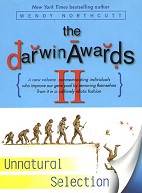Classic Dozen: Better Read than Dead
( Excerpt from Chapter 10 )
 1995
Darwin Award Winner: JATO 1995
Darwin Award Winner: JATO
(Debunked by Darwin) The Arizona Highway Patrol were mystified when
they came upon a pile of smoldering wreckage embedded in the side of
a cliff rising above the road at the apex of a curve. The metal debris
resembled the site of an airplane crash, but it turned out to be the
vaporized remains of an automobile. The make of the vehicle was unidentifiable
at the scene.
The folks in the lab finally figured out what it was, and pieced together
the events that led up to its demise. It seems that a former air force
sergeant had somehow got hold of a Jet-Assisted Take-Off (JATO) unit.
JATO units are solid-fuel rockets used to give heavy military transport
airplanes an extra push for takeoff from short airfields.
Dried desert lakebeds are the location of choice for breaking the world
ground vehicle speed record. The sergeant took the JATO unit into the
Arizona desert and found a long, straight stretch of road. He attached
the JATO unit to his car, jumped in, accelerated to a high speed, and
fired off the rocket.
The facts, as best as could be determined, are as follows:
The operator was driving a 1967 Chevy Impala. He ignited the JATO unit
approximately 3.9 miles from the crash site. This was established by
the location of a prominently scorched and melted strip of asphalt.
The vehicle quickly reached a speed of between 250 and 300 miles per
hour and continued at that speed, under full power, for an additional
twenty to twenty-five seconds. The soon-to-be pilot experienced G-forces
usually reserved for dogfighting F-14 jocks under full afterburners.
The Chevy remained on the straight highway for approximately 2.6 miles
(fifteen to twenty seconds) before the driver applied the brakes, completely
melting them, blowing the tires, and leaving thick rubber marks on the
road surface. The vehicle then became airborne for an additional 1.3
miles, impacted the cliff face at a height of 125 feet, and left a blackened
crater three feet deep in the rock.
Most of the driver's remains were not recovered; however, small fragments
of bone, teeth, and hair were extracted from the crater, and fingernail
and bone shards were removed from a piece of debris believed to be a
portion of the steering wheel.
Ironically, a still-legible bumper sticker was found: "How do
you like my driving? Dial 1-800-EAT-SHIT."
Sidebar: This Darwin Award is the most popular of
all time. Considered true for years, it was later confirmed as an Urban
Legend by the Arizona Department of Public Safety. The story fooled
the judges in 1995, so JATO has been grandfathered in as the 1995 Darwin
Award Winner. Officer Bob Stein of the Arizona Department of Public
Safety talks about the JATO story. "I receive inquiries about accidents,
drug busts, and investigations. About two years ago I picked up the
phone and researched what has now become an Arizona myth. Even now I
receive about five calls a month from people wanting to know, did it
really happen?" Read the Official Arizona JATO denial.
C h a p t e r 10 S t o r i e s
JATO
Junk Food Junkie
Midnight Special
Wrong Time, Wrong Place
Count Your Chickens
The Last Supper
|
Lawnchair
Larry
Revenge of the Gopher
Frog Giggin' Accident
Metallica Concert Misadventure
Scuba Divers and Forest Fires
Dog and Jeep |
Darwin Awards - Honorable Mentions - Urban Legends - Personal Accounts
Chapter Links:
Photos of Thomas' qualifying demonstration.
Denunciation of the "Frog Giggin'" Story.
Author Bio:
Wendy Northcutt holds a degree in molecular biology
from UC Berkeley. She began writing Darwin Awards
in 1993, and founded the website soon thereafter.
|


 1995
Darwin Award Winner: JATO
1995
Darwin Award Winner: JATO